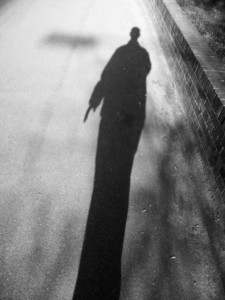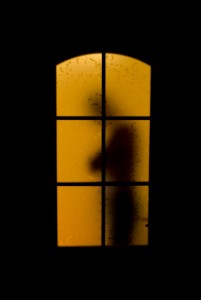Clothed in Clarity, Veiled in Light (Part 2)
By Asher Crispe: May 29, 2012: Category Decoding the Tradition, Inspirations
Approaching Modesty and Mystery in Kabbalah, Philosophy and Science
 Synoptics: The Violence of Vision
Synoptics: The Violence of Vision
—Dizziness,
Vertigo high above a mirror.
The garden sinks.
Now it is a name with no substance.
The signs are erased:
I watch clarity.
Octavio Paz(13)
Addicted and hypnotized by the power of the eyes to penetrate and reveal the world and its manifold objects, we are persuaded by their ability to serve up reality to mind and memory. Content to forget the disparity between appearance and reality, we often proceed without caution, embracing the acuity of our own field of vision. Our binocular vision certifies the philosopher as optician to penetrate the world of objects who surrender to our over-looking. Amongst the critiques of the conceited partnership of philosophy and vision, we find the multiple studies of David Michael Levin. For Levin:
This gaze is always looking for others who are either exactly the same or else predictably, stereotypically, absolutely different, others whose perceived sameness or difference will absolutely confirm the driving prejudice. This is a gaze, then, which, being intolerant of ambiguity, either reduces otherness of the other to an absolute identity (totalitarian solidarity), or else demonizes the other’s otherness, making it an otherness so absolutely different that no empathic projection, and no recognition of the humanity of the other, is possible. (14)
For Levin and a host of other postmodern voices he assembles within his texts, the unbridled use of synoptic vision assumes the givenness of its objects to the satisfaction of a voyeuristic epistemic impulse. Compounding assumption on assumption, we witness a dual-directional reductionism of observer to observed and observed to observer. Tasked with the age-old question as to whether or not I see what I want to see in contrast to seeing what is actually there, we develop an immediate solution in the form of half-acceptance of our bifocal vision. Consentient with the subject representing both sides of the case under trial, in the reflections and inflections of eyes, lenses, and mirrors, we learn to live with double vision. Some objects are closer than they appear—some farther away. The distance to our minds is secondary to their overall approachability. Steering around blind spots, we overcompensate, excepting a measure of myopic and hyperopic convergences.
Practically speaking, to size up a person just by looking at him or her so as to not leave oneself in the dark as to whom one is dealing with, marks the mission of vision. As Levinas expresses it: “Vision moves into grasp.” (15) Would only all objects volunteer to be bathed in light our success would be sealed. Knowing the difficulty of using cumbersome optical equipment to enhance images, we would prefer voluntary admissions. Nonetheless, we are willing and ready to storm the frontier by force, effacing the distinction between willing to see and willing to be seen. In Heideggerian parlance: “The factical uncoveredness of anything is always, as it were, a kind of robbery.”(16)
Stolen glances as part of the “imperialism of theoria”(17) shape up to the violence of vision. Being game for the strictly empirical is passed off as the constitution of good science, and yet, on a need-to-know basis, we detest impaired vision and extrapolate over the horizon. We manipulate what has been seen with the furious methods of induction and deduction until the spirits of long ago join those of the unborn future in candid revelation to the spectrum of the present. We are reading a map of the past while driving into the future carried along in the vehicle of the present, alternating our attention between what is present to us in time and space and what we feel called upon to envision.
Wandering eyes, false fixations, and misalignments serve arrest warrants to unsuspecting people on the run. Once caught and subject to violation, the observed discovers how hard it is to shake off the semblance impressed and self-certified in the eye of the beholder. For some, to see without being seen folds into a question of being seen without being seen. Modesty moderates how much a person pours into their self-image compared with what he or she holds in reserve as a measure of private life that avoids detection.
 Octavio Paz’s brilliant words: “The world a bundle of your images”(18) breaks open the synoptic status of vision, obliging us to think of their multiplicity with candor. Escaping the “look” as Sartre describes it, where “…the problem of Others has generally been treated as if the primary relation by which the Other is discovered is object-ness; that is, as if the Other were first revealed—directly or indirectly—to our perception.”(19)
Octavio Paz’s brilliant words: “The world a bundle of your images”(18) breaks open the synoptic status of vision, obliging us to think of their multiplicity with candor. Escaping the “look” as Sartre describes it, where “…the problem of Others has generally been treated as if the primary relation by which the Other is discovered is object-ness; that is, as if the Other were first revealed—directly or indirectly—to our perception.”(19)
This necessitates the rethinking of the other outside of photology. (20) Perhaps we can learn to maintain a parallax gap(21) and avoid a situation where, as Adorno put it “such staring magically transforms all becoming into being.”(22)
13 From “A Tale of Two Gardens”: Collected Poems p.307.
14 The Philosopher’s Gaze, p.50. Levin’s returns to this theme again and again. One of his great compilations of essays on the subject: Modernity and the Hegemony of Vision contains an excellent summary of the problem in John McCumber’s essay “Derrida and the Closure of Vision” (pp.234-251). MacCumber maintains that:
The philosophers’ use of vision as a model for knowledge, then, gives us what we Westerners call ‘vision.’ Such vision has four main characteristics. First, it is centered on the notion of ‘presence,’ itself understood on two levels: temporally, as the independence of the present moment from past and future; and epistemologically, as the presence-to-self, or self-certainty, of consciousness….
Second: The object of such vision—the particular kind of present at which it aims—is independent of its temporal context—and hence of all context. It is self-sufficient, then, against the flux of time. It is—form: ‘Form is presence itself. Formality is that which presents itself in the thing in general, allows itself to be seen, gives itself to thought.’ [Derrida Margin p.158]
Third: If vision is knowledge, and vision delivers forms, then (as Aristotle argued in much detail) the thing can be known only insofar as it is form. So understood, philosophy’s founding assimilation of knowledge to vision is authorized by form: ‘The metaphysical domination of the concept of form cannot fail to give rise to a sort of submission to the gaze.’[Derrida margins p.158] There is, of course, a price to be paid for this, and that is the suppression of the other of form: of matter. The visionary model for knowledge thus becomes complicitous with what Derrida calls, in La Voix et le phénomène, the ‘founding opposition of metaphysics,’ that of form and matter, and with the reduction of matter to unknowability. [Derrida p. 63]
Fourth: sight, thus subjected to form, becomes sound. For to reduce a being to its form means to assimilate it to the knower, as Aristotle pointed out; and such assimilation can only be fully achieved when the object becomes, not merely assimilated to, but lodged within, the knower. (Pp.236-7)
15 Totality and Infinity, p.191.
16 Being and Time, pp.264-265.
17 See Derrida, Margins of Philosophy pp.253-254 and pp.266-267.
18 From “Blanco”: Collected Poems p.323.
19 Being and Nothingness, p.253.
20 “The metaphor of shadow and light (of self-showing and self-hiding) [is the] founding metaphor of occidental philosophy as metaphysics…The entire history of our philosophy is a photology.” Derrida “Form and Signification” in Writing and Difference, p.45/27 as quoted in Levin, Modernity and the Hegemony of Vision, p.235.
21 See Slavoj Žižek, The Parallax View, p. 4: “an insurmountable parallax gap, the confrontation of two closely linked perspectives between which no neutral common ground is possible.”
22 Against Epistemology, p.152. See also The Philosopher’s Gaze, p.70 for a discussion of this idea in Adorno thought.
http://www.interinclusion.org/inspirations/clothed-in-clarity-veiled-in-light-part-3/
Clothed in Clarity, Veiled in Light (Part 2),























;)
;)
;)
;)
;)
;)
;)
;)
;)
;)
